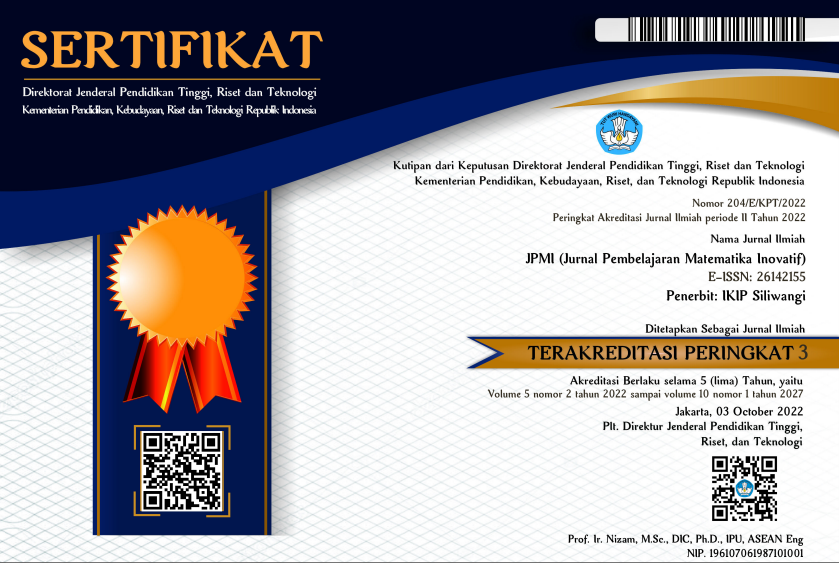ANALISIS KESULITAN MENYELESAIKAN MASALAH MATEMATIS BERKAITAN DENGAN PERTANIAN DITINJAU DARI MOTIVASI BELAJAR MATEMATIS MAHASISWA
DOI:
https://doi.org/10.22460/jpmi.v6i1.11531Kata Kunci:
Difficulty, Mathematical Problems, Agriculture, Mathematics Learning MotivationAbstrak
Referensi
Agsya, F. M., Maimunah, & Roza, Y. (2019). Analisis Kemampuan Pemecahan Masalah Ditinjau Dari Motivasi Belajar Siswa MTS. Pasundan Journal of Research in Mathematics Learning and Education, 4(2), 31–44.
Agustina, J. (2018). Penerapan Model Pembelajaran Problem Based Learning (PBL) Untuk Meningkatkan Kemampuan Pemahaman Konsep Matematis Mahasiswa S1 Tadris Matematika IAIN Bengkulu. Jurnal Equcation : Teori Dan Penelitian Matematika, 1(1), 25–38.
Aspriyani, R. (2017). Pengaruh Motivasi Berprestasi Siswa Terhadap Kemampuan Pemecahan Masalah Matematis. Jurnal Penelitian Dan Pembelajaran Matematika, 10(1). https://doi.org/10.30870/jppm.v10i1.1194
Handhika, J. (2012). Efektivitas Media Pembelajaran Im3 Ditinjau Dari Motivasi Belajar. Jurnal Pendidikan IPA Indonesia, 1(2), 109–114. https://doi.org/10.15294/jpii.v1i2.2127
Kartika, Y. (2018). Analisis Kemampuan Pemahaman Konsep Matematis Peserta Didik Kelas Vii Smp Pada Materi Bentuk Aljabar. Jurnal Pendidikan Tambusai, 2(2), 777–785.
Khotimah, N., Utami, C., & Prihatiningtyas, N. C. (2018). Penerapan Model Learning Cycle 7E Untuk Meningkatkan Kemampuan Literasi Matematis Siswa Kelas VIII Pada Materi Prisma. JPMI (Jurnal Pendidikan Matematika Indonesia), 3(1), 15. https://doi.org/10.26737/jpmi.v3i1.457
Masnia, F., & Amir, Z. (2019). Pengaruh Penerapan Model Scaffolding terhadap Kemampuan Pemahaman Konsep Matematis Berdasarkan SElf Efficacy Siswa SMP. JURING (Journal for Research in Mathematics Learning), 2(3), 249. https://doi.org/10.24014/juring.v2i3.7675
Novitasari, D. (2016). Pengaruh Penggunaan Multimedia Interaktif Terhadap Kemampuan Pemahaman Konsep Matematis Siswa. FIBONACCI: Jurnal Pendidikan Matematika Dan Matematika, 2(2), 8. https://doi.org/10.24853/fbc.2.2.8-18
Nursoffina, M. (2022). Analisis Hubungan Penalaran Matematis dengan Pemecahan Masalah terhadap Materi Matematika Siswa SD. Academia Open, 6.
Olpado, S. U. & Heryani, Y. (2017). Korelasi antara Motivasi Belajar dengan Kemampuan Pemecahan Masalah Matematik Peserta Didik menggunakan Model Problem Based Learning. Jurnal Penelitian Dan Pengajaran Matematika, 3(1), 63–70.
Sugiyono. (2016). Metode Penelitian Pendidikan: Pendekatan Kuantitatif, Kualitatif, dan R & D. AlfaBeta.
Sundayana, R. (2013). Media Pembelajaran Matematika. AlfaBeta.
Wahyuddin, W. (2017). Analisis Kemampuan Pemecahan Masalah Matematika Ekonomi Ditinjau Dari Kemampuan Berpikir Logis Pada Mahasiswa. AdMathEdu : Jurnal Ilmiah Pendidikan Matematika, Ilmu Matematika Dan Matematika Terapan, 7(2), 211. https://doi.org/10.12928/admathedu.v7i2.9160
Wahyuni, R., Utami, C., & Husna, N. (2016). Pengaruh Model Role Playing Terhadap Kemampuan Komunikasi Matematis Siswa Pada Materi Fungsi Komposisi Kelas XI Sma Negeri 6 Singkawang. JPMI (Jurnal Pendidikan Matematika Indonesia), 1(2), 81. https://doi.org/10.26737/jpmi.v1i2.87
Unduhan
Diterbitkan
Terbitan
Bagian
Lisensi
Hak Cipta (c) 2023 JPMI (Jurnal Pembelajaran Matematika Inovatif)

Artikel ini berlisensiCreative Commons Attribution-ShareAlike 4.0 International License.
The author is responsible for acquiring the permission(s) to reproduce any copyrighted figures, tables, data, or text that are being used in the submitted paper. Authors should note that text quotations of more than 250 words from a published or copyrighted work will require grant of permission from the original publisher to reprint. The written permission letter(s) must be submitted together with the manuscript.
















